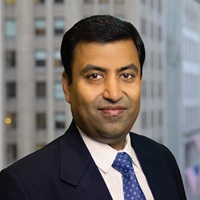Joel Connell (Bell Asset Management) and Rakesh Bordia (Pzena Investment Management) explore opportunities in global SMID caps and emerging markets to consider for your investors looking for growth outside of Australia.
When investors talk about small and mid (SMID) caps and emerging market equities, it’s common for the focus to be on growth. Naturally, people want to allocate into these markets, because they see them as being high growth. However, that’s not always the case, with value often being important when allocating into these markets.
It’s a view supported by Joel Connell — Portfolio Manager at Bell Asset Management — who believes global SMIDs are underappreciated by investors, with many quality companies remaining ‘off the radar’ for investors.

By Jayson Forrest
Jason Petras
Resonant Asset Management.

Joel Connell
Bell Asset
Management

Rakesh Bordia
Pzena Investment Management

In a webinar focused on investment opportunities in global SMID caps and emerging markets (as part of an IMAP Specialist Webinar Series on ‘Growth outside of Australia’), Joel says there are often misconceptions that associate SMIDs with speculative start-ups or thinly traded local companies. However, the reality of the global SMID universe is very different.
He says these companies are much more robust than many investors think.
In terms of size, Joel says the vast majority of global SMIDs (a market of about 7,500 companies) sit between US$1 billion and US$50 billion in market cap.
In comparison, he points to the local market where there are currently about nine ASX-listed stocks that have a market cap above US$50 billion, with plenty of household names (like Woolworths and Telstra) sitting below this level.
“In the context of Australia, global SMID caps include some sizeable companies, but on a global scale, they are fundamentally different to what you’d find in the large cap part of the market,” he says. “Ultimately, the global SMID universe is perhaps larger and more mature than many people realise, but importantly, they offer unique investment opportunities to what you might find in all cap or large cap strategies.”
Ultimately, SMID cap companies are under-researched and under-owned by institutional investors. So, for skilled active managers, this presents opportunities, as often there are more mispricings to take advantage of
Enhanced diversification
In making the case for global SMIDs, Joel says one of the key benefits of allocating to this market is the enhanced diversification it can bring to a portfolio.
Whilst acknowledging that stock/sector concentration (like mega cap tech stocks) can provide “big pay offs when things go right”, it can just as easily turn into a headwind if the market shifts or a handful of stocks begin to falter.
“For example, in the ASX 300, the top 10 stocks make up nearly half of the entire index, with CBA alone at over 10 per cent. And if we add together the financials and materials sectors, that’s 50 per cent of the index in just two sectors. So, that’s a lot of concentration risk.”
Joel adds it’s a similar story in global large caps, where in the MSCI World Large Cap Index, the top 10 companies represent over 30 per cent of the index and contributed 60 per cent of the total return of this index in 2024. It’s a staggering figure, considering there is nearly 600 companies in this index.
By contrast, the global SMID cap universe is far more diversified across sectors, stocks, and geographies. The top 10 stocks in the MSCI World SMID Cap Index make up just under 3 per cent of the total.
“We believe those investors who have benefitted from more concentrated bets, like mega cap tech stocks, should consider reallocating some of their profits into other segments, like global SMID caps, which makes a lot of sense.”
If you combine emerging markets investing with a very disciplined value investing approach and a long-term investment horizon, then emerging markets become an ‘all weather’ strategy that works well in almost all situations
Outperformance of global SMIDs
Importantly, Joel says using global SMIDs to diversify a portfolio doesn’t have to come at the expense of sacrificing returns. Looking over the past 25 years, global SMIDs have outperformed global large caps by about 1.2 per cent per annum, which due to the power of compounding, does translate into substantial differences in total returns over time.
Joel attributes the reason for this long-term outperformance to growth. He says global SMIDs have consistently delivered faster revenue and faster earnings growth than their large cap peers, and are forecasted to continue to do so.
“We think this faster growth is a durable characteristic of this segment of the market, due to the structural advantages of SMIDs,” he says. “They are often earlier in their lifecycle, have a longer runway for expansion, and more ‘white space’ opportunities to capture share. And SMID caps are often more agile and better positioned to innovate, which means they can often pivot more quickly to new trends or respond to competitive threats.”
According to Joel, these characteristics combine to create superior revenue and earnings growth, which compounds over time into higher investor returns.
Another advantage of global SMID caps lies in their ability to remain largely undiscovered by market analysts. Joel refers to these companies as ‘hidden gems’, because they are significantly less picked over by the broader investment market. On average, a company within the MSCI World SMID Cap Index is covered by only nine sell-side analysts, compared to the Magnificent Seven (Mag 7) which has 72 analysts, Top 20 companies with 50 analysts, and Top 50 companies with an average of 40 analysts.
“Ultimately, SMID cap companies are under-researched and under-owned by institutional investors. So, for skilled active managers, this presents opportunities, as often there are more mispricings to take advantage of.”
Over the past 5-7 years, the Mag 7 have compounded their earnings at over 30 per cent per annum, and shareholder returns have been even more than that, because of valuation expansion. But over the next couple of years, the forecast earnings growth for the Mag 7 is only around 12-13 per cent per annum, which is quite a deceleration in earnings growth
Attractive valuations
Over the last 5-7 years, Joel acknowledges that SMIDs have lagged mega and large caps, due to market sentiment and valuation multiples. He says this recent underperformance has not occurred because their earnings or fundamentals have been weaker, but it’s been almost entirely due to their valuations sharply diverging from large caps.
Joel explains: “The MSCI World SMID Cap Index is currently (September 2025) trading at about a 15 per cent discount to large caps. This discount is particularly noteworthy when you consider that SMID caps have delivered superior earnings growth over time. So, essentially, investors in SMID caps are getting higher growth for a significantly lower price.
“And if you compare this to the MSCI World Large Cap Growth Index or the Mag 7, the discount widens to 39 per cent. Historically, SMIDs have traded at a premium to large caps, so we think this current dislocation is notable and we believe it creates a compelling case for global SMIDs going forward.”
Some of the global SMID cap companies Bell Asset Management likes include: AutoTrader (the UK’s leading online marketplace for the sale of cars); Veeva (a US leader in cloud-based software for the global life sciences industry); OBIC (a Japanese enterprise software company); Rightmove (the UK’s largest online real estate property portal); DISCO (a Japanese manufacturer of precision processing equipment and semiconductor tools); and Straumann (a Swiss-based dental implants company).
“There are many companies that are dominant in their respective fields, but still largely live under the radar of many generalist and large cap investors,” says Joel. “We see multiple tailwinds for global SMIDs, like interest rate cuts and better clarity on tariffs, which we think are supportive of this market.
“When you put everything together, we believe global SMID caps offer a very compelling opportunity for strong risk-adjusted returns, and certainly warrants a serious look at for client portfolios.”
Emerging markets is a segment where value works really well. This is a great time to be investing in emerging market value strategies, given the valuation discount to developed markets. Emerging markets also provide a very good ballast to the rest of the portfolio due to the counter-cyclical nature of value strategies in emerging markets
Value in emerging markets
Pzena Investment Management identifies emerging markets as another segment of the market that offers investors plenty of opportunities. Its approach to emerging market equities is to invest in superior businesses that have a significant competitive advantage, a good cost structure, scale, good use of technology, and which can also generate higher returns over a cycle.
According to Rakesh Bordia — Principal and Portfolio Manager at Pzena Investment Management — Pzena also seeks to invest in businesses with very strong downside risk management, “because a lot of these businesses may take a long time to normalise”.
A question Rakesh is often asked is: Does value work in emerging markets? He believes value works better in emerging markets than many other sectors, because investors over-react and become fearful (for whatever reason) when investing, which creates price dislocations that investors, like Pzena, can capitalise on.
“If you combine emerging markets investing with a very disciplined value investing approach and a long-term investment horizon, then emerging markets become an ‘all weather’ strategy that works well in almost all situations,” says Rakesh.
There are some excellent quality companies that have great long-term tailwinds, which are on sale right now. Buying these quality companies is where we’re going to make money over the next 5-10 years
Value in emerging markets
Despite emerging markets recently going through a period of underperformance, Rakesh remains bullish on the opportunities that emerging market stocks offer.
“If you look at emerging market returns over the past 25 years (since the start of this century), the first decade saw emerging markets significantly outperform developed markets. Then over the following 10-15 years, emerging markets have underperformed, mostly driven by what’s happened in the US, Europe, Japan, and China.”
Rakesh says much of that underperformance can be attributed to China, which has been the biggest driver of returns in emerging markets. Whilst China did well in the first decade, it has since weakened over the past 10-15 years.
However, he believes investors should remain confident with emerging markets, which offer considerable value compared to many other markets. When considering emerging markets, Rakesh says the sector is currently trading at a significant discount to developed markets, while showing stronger fundamentals, rising credit quality, and lower sensitivity to US specific risks.
As of May 2025, MSCI research found that US equities were trading at over 21x forward earnings, compared to 12x for emerging market equities — one of the widest valuation spreads in the last two decades. A spread this wide suggests investors may find opportunities in companies of emerging market countries that have gradually strengthened their fundamentals and are enjoying increasing macroeconomic stability.
Rakesh believes a benefit of investing in value strategies is they’re much more counter-cyclical to index-driven pro-cyclical strategies. Pzena has low correlation with other managers that are not value investors.
“Emerging markets is a segment where value works really well. This is a great time to be investing in emerging market value strategies, given the valuation discount to developed markets. Emerging markets also provide a very good ballast to the rest of the portfolio due to the counter-cyclical nature of value strategies in emerging markets.”
AI and the benefits of scale
When considering the expected capex spend on artificial intelligence (AI) by the Mag 7 to be about US$330 billion this year alone, Joel acknowledges that scale, and the benefits this brings to a company over time, does present challenges for SMIDs.
However, while there’s no doubt that mega cap tech stocks have delivered exceptional returns over the past 5-10 years, looking forward, Joel expects there will be a deceleration of the earnings growth of the Mag 7.
“Over the past 5-7 years, the Mag 7 have compounded their earnings at over 30 per cent per annum, and shareholder returns have been even more than that, because of valuation expansion,” says Joel. “But over the next couple of years, the forecast earnings growth for the Mag 7 is only around 12-13 per cent per annum, which is quite a deceleration in earnings growth.”
He says compare that to the MSCI World SMID Cap Index, where the earnings growth is expected to be closer to 14-15 per cent. Effectively, this means investors are getting higher growth at a significant discount, because global SMID caps are trading at about a 40 per cent discount to the Mag 7.
“Investors need to be selective in the companies they invest in,” says Joel. “There are certainly a lot of companies in the global SMIDs cap space we invest in that will be beneficiaries of AI. They will incorporate AI into their businesses to drive margin expansion and efficiencies, and improve their margin profile.”
Joel adds it still needs to be seen whether the Mag 7 will get a return on investment with their AI spend. He believes if anything happens that questions the return on this investment, it could easily cause Mag 7 stocks to sell off.
Rakesh agrees, adding that when it comes to investing, it’s all about valuation. He says there are also many hidden gems in emerging markets. For example, Pzena owns Elite Material — a Taiwan-based company principally engaged in the manufacture, processing and distribution of base materials for the printed circuit board industry, including AI servers.
“Elite Material was a very small business four years ago, but after AI took off, it’s become much larger. So, if you can conduct deep research into these kind of businesses and identify their competitive advantage, then there’s great opportunity and value by investing in these businesses,” says Rakesh.
“And remember, the result of the investment in AI by Mag 7 will end up in products and services that will be sold to other companies to improve their operations. So, there are businesses that will benefit tremendously from this AI spend in emerging markets, which is often a forgotten part of the market.”
Secular themes driving long-term growth
Looking forward over the next 10 years, Rakesh believes the secular themes that will drive long-term returns revolve around population trends and improving governance structures in emerging markets.
“Twenty-five years ago, there were no industry leaders in emerging markets, but today, we have leaders in technology, automotive, and many other industries. From a secular standpoint, this is why the valuation of assets in emerging markets should continue to rise over time,” he says. “The opportunity within emerging markets is the ability to find those areas where growth has not already been priced in.”
As an example, he cites India, where the fundamentals are solid: it has a large and growing middle class; it is a democracy governed by the rule of law; and it has improving governance and economic structures. However, looking at the valuations in the Indian market, a great deal of optimising has already been priced in. “So, while all the structural elements could be right, you still might not make money in that market.”
However, Rakesh believes that although the fundamental trends are structurally good for emerging markets, it’s still going to be a stock picker’s or research-driven investor market for the foreseeable future.
And what about global SMID caps?
As bottom-up investors, Bell Asset Management seeks a diversified spread across various sectors, to ensure it benefits from the tailwinds coming from the likes of healthcare, software, automation, and AI.
“For us, it’s about identifying quality companies that can continue to compound their earnings growth over time, irrespective of what the external environment is doing. Over the past 12-18 months, quality in developed markets has actually had a really tough time. So, there are many amazing quality companies currently on sale. If you can buy these quality companies and they can compound their earnings over the next 10 years, investors can make some very strong returns,” says Joel.
“There are some excellent quality companies that have great long-term tailwinds, which are on sale right now. Buying these quality companies is where we’re going to make money over the next 5-10 years.”
About
Joel Connell is a Portfolio Manager at Bell Asset Management; and
Rakesh Bordia is Principal and Portfolio Manager at Pzena Investment Management.
They spoke on the topic of ‘Names your clients haven’t heard of’ at an IMAP Specialist Webinar Series on ‘Growth outside of Australia’.
The session was moderated by Jason Petras — Director, Investments at Resonant Asset Management.

